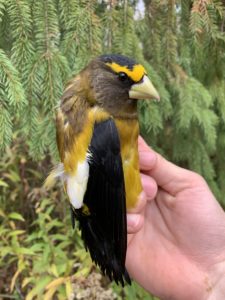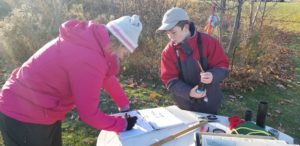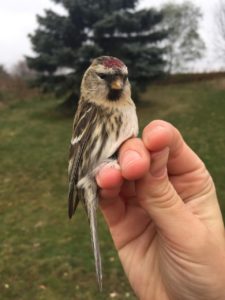Although we have stopped banding at Ruthven, we have not stopped banding. In fact, the Fall was quite busy. Ben Oldfield’s site near Lowville provided a lot of opportunity and this was rewarded with excellent catches and variety. See his brief summary below:
This fall we banded 945 birds compromised of 72 species. The make up of major groups are as follows. Catharus thrush (7.7%), warblers (11.5%), sparrows (24.9%). Finches were banded in high numbers, Evening Grosbeaks were a highlight. [Saw-whet] Owls this year came through in good numbers, with 107 owls banded. This would be a record for even Ruthven, and only 7 nights were attempted which is very low. The habitat and location where this station is located is fantastic for not only songbirds but owls. Banding took place on average 2 times a week, and for 4 hours. The capture rate was generally very steady. All in all a great season, I am glad we were able to have some of the kids out and keep banding going.

Brilliant male Evening Grosbeak – an irruptive species that is seen rarely now in southern Ontario. -MMG
Banding would be more then possible at this location in the spring, it is a great site that should be used and is the next best alternative to Ruthven in my opinion.

Evening Grosbeaks, as the name would imply, have very powerful bills – that hurt considerably more than a Northern Cardinals. -MMG
All the best and I do apologize for missing many [board] meetings. Between university, working weekends/nights and other seminars I find myself busy. [I see he didn’t mention girlfriend.] Enjoy the winter and stay safe.
Best,
Benjamin Oldfield [pictured above….a few years ago]

In the beginning [in early November] there was keen interest and family support (and it was green and sunny). JH
And, of course, we continue to band at Fern Hill’s two campuses, in Burlington and Oakville. This is also an exercise in studying birds in areas of increasing urban pressure. But it’s surprising what can show up at these two schools:

Fern Hill School can have its surprises: a Common Redpoll – part of the Winter finch irruption. -KAP
Rick




